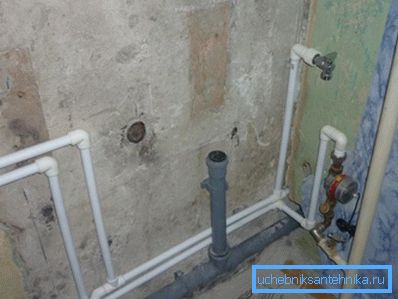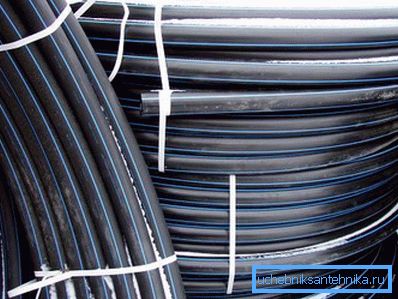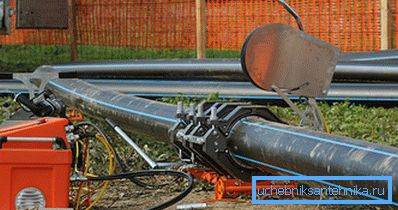Hdpe pipe dimensions and its other characteristics
What is this material - PND? What diameters of HDPE pipes can be found on sale? What standards is regulated production? Let's try to answer these and some other questions.

What it is
PND is a common abbreviation for low-pressure polyethylene. However, before proceeding to a detailed study of the size and other characteristics, we will get acquainted with the more general features of the material.
Polyethylene: General Properties
What we know about polyethylene:
- This is the most common of thermoplastics (polymers, reversibly changing their physical properties when heated). Once the production technology is well established, it is logical to expect the price of materials to be low.
- Speaking of heating: already at 80 ° C, polyethylene begins to soften. The strength of pipes to rupture catastrophically falls at much lower temperatures, so most manufacturers limit the operating mode to 40 - 45 degrees Celsius.
Curiously: cross-linked polyethylene (a polymer whose molecules are connected by cross-linking) is much more heat-resistant and is successfully used for pipelines for heating and hot-water supply.
- Plastic has extremely low adhesive properties.. Simply put, other materials do not stick to its surface. If so - overgrowth of pressure pipes with mineral deposits can not be afraid.
- Cold water life is estimated at 50 years or more..
- Like all plastics, polyethylene is a dielectric.
- It is extremely resistant to aggressive environments.. Concentrated acids and alkalis are often supplied in sealed plastic packages.

HDPE and LDPE
Polyethylene, as is easy to guess from its name, is a product of the polymerization of ethylene gas. Depending on the conditions under which it passes, you can get a material with quite different properties.
| Title | Description of polymerization conditions |
| High Pressure Polyethylene (LDPE) | Temperature 200-260C; pressure - 150-300 MPa; presence of initiating oxygen reaction |
| Low Pressure Polyethylene (HDPE) | Temperature 100-120С; pressure - 0.1 - 2 MPa; catalyst presence |
LDPE has a lower mechanical strength and is used mainly for pipelines with a slight overpressure. Its alternative name is low density polyethylene. PND, or PVP (high density polyethylene), in contrast, is much more durable and is widely used in pressure pipelines.

Curiously: the current standards do not share the HDPE and LDPE. And sewer, and pressure pipes can be made from both types of plastic. A table of diameters of HDPE and LDPE pipes is also common.
Options
It is clear that the main parameter characterizing the pipeline is its diameter. They determine the bandwidth.
However, the description of the material is not limited to them: for example, the full technical characteristics of a 110 mm PND pipe include several more important parameters.
- Wall thickness Its increase at a constant nominal diameter increases the strength of the pipeline in relation to the internal hydrostatic pressure.
- SDR is the standard dimensional ratio, a fraction with an outer diameter in the numerator and a wall thickness in the denominator. The larger the SDR, the lower the working pressure of the pipe: an increase in the wall area at their fixed thickness and strength properties reduces the ability of the pipeline to withstand hydraulic pressure.

- MRS - maximum durability. Unit of measurement - MPa (megapascals). Simply put, this is the maximum stress in the walls at which the pipe will serve for 50 years at a temperature of + 20 ° C.
- MOP - maximum working pressure.
- S is a series of pipes, calculated as MRS / 1.25 / MOP, where 1.25 is the safety factor for water.
- In addition, products can be designed for the transport of drinking water or exclusively for technical needs.
What does the marking of type PE 32, PE 63 (sometimes incorrectly indicated as HDPE pipe 63), PE 80 and PE 100 mean? Only that the maximum long-term strength of the MRS corresponds to ten times the smaller value:
| Type of polyethylene | MRS, MPa |
| PE 32 | 3.2 |
| PE 63 | 6.3 |
| PE 80 | 8.0 |
| PE 100 | 10.0 |
Important: all the above parameters are relevant for pressure pipe elements. The sewer pipe PND 110 mm has no additional characteristics, except for the nominal diameter.

Legend
The designation of the pressure pipe must contain:
- The word trumpet.
- Reference to material and MRS (PE 32, PE 63 and so on).
- SDR option.
- Dash.
- Nominal diameter and nominal wall thickness.
- Appointment (drinking or technical).
- The name of the standard by which the product is manufactured (GOST 18599-2001).
Thus, the inscription of the type Pipe PE 80 SDR 9 - 90 x 10.1 drinking GOST 18599-2001 means that we have a pipe PND 90 mm in diameter with 10.1 mm walls, intended for drinking water supply.

Assortment
One of the standards that contains a range of polyethylene pipes, we have just mentioned - GOST 18599-2001 regulates the manufacture of material for pressure pipelines.
The second standard - GOST 22689.1-89 - describes a range of polyethylene sewage. So, what should be the size of the products we are interested in?
GOST 22689.1-89
The document provides a total of four sizes: 40, 50, 90 and 110 mm.
Where do they apply?
- 40 mm is the typical knee size for draining wastewater from a single washbasin or sink.
- Pipe PND 50 mm can drain wastewater from two or three plumbing fixtures (excluding toilet bowls).

Note! Devices with the possibility of salvo discharge (for example, a bathtub and a shower), when mounting with your own hands, it is better to connect to the outlet of a larger section. The instruction is connected with the fact that when the bath is drained, the 50-mm tube is likely to overflow (especially if inside it is partially filled with fatty deposits), and the drains will flow through the grate into the device with a lower output.
- 90 is a typical cross-section for connecting mounted toilet bowls.
- 110 is the most universal size used to connect floor-mounted toilet bowls, to construct sewage risers and plank beds (horizontal branches uniting several risers).
GOST 18599-2001
The full list of dimensions within the framework of this document is too large for a small article; therefore, we will only denote boundary values.
- PE 32 (or, as it is sometimes incorrectly called, PND 32 pipe) may have a diameter of 10–160 mm with a wall thickness of 2.0–20.8.

- Characteristics of the PND 63 (PE 63) pipe may include a wall thickness of 2.0 - 57.2 mm with a diameter of 16 - 1200.
- PE 80: diameter 16 - 1200, walls 2.0 - 59.3.
- PE 100: diameter 32 - 1000, wall thickness 3.0 - 59.3.
Where it is appropriate to use a particular size at home?
- The pipe PND of 20 mm will provide with water supply the apartment or the small house with one bathroom.
- If water supply is supposed not only for household needs, but also for irrigation, a PND pipe of 25 mm is used. Other, in addition to diameter, the characteristics of the pipe PND 25 mm are determined solely by the working pressure of the water supply; for centralized water supply systems it is better to use PE 80 SDR 9.
Glands larger than the above sizes are usually used for water supply of groups of cottages, and with a diameter of more than 100 mm - cottage villages and apartment buildings.

Conclusion
We hope that we managed to satisfy the reader’s curiosity in the field of acquaintance with one of the most popular modern materials. As usual, the video in this article will offer him more information. Successes!